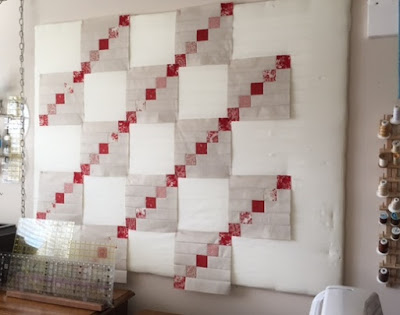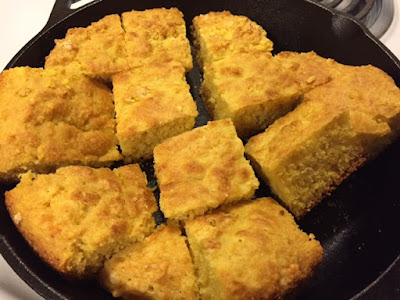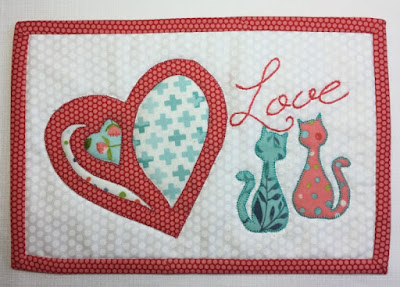Last year was the year of fleece robes for everyone. This year, Christmas sewing time was short. It's hard to fin
d quick projects that are suitable for the four guys in my family, and since I needed a quick project, it became the year of the zippered pouch for everyone. I even have an extra for one myself.
My family loved the pouches, but the "stuffing" I put inside of them turned out to be the most fun of the day. You can see what it was at the end of this tutorial.
 |
| Seven pouches in four easy days. |
I thought the sewing might go quicker with instructions, so I researched a few tutorials searching for a good one. The first one I found was so hard to follow that I looked up another. And another. And another. I finally gave up and figured out my own method. The pouch is fully lined, and after I'd made the first one, I found I could whip up one in the morning and another after lunch. I still had time left over for grocery shopping, cooking meals, frosting cookies, and catching up on my favorite Netflix show.
This is how I made them.
Fully Lined Zippered Pouch - 5" x 5 1/2" x 10 1/2"
Fabrics and Materials
- 2 fat quarters of coordinated fabrics for the outside of the pouch
- 1/2 yard of lining fabric
- 1/2 yard of fusible fleece (45" wide)
- One 18" or 20" zipper (If the zipper is too long it can easily be cut to size.)
- Thread
Cutting Instructions
1. From one fat quarter, cut a rectangle 11" x 16". Cut a matching rectangle of fusible fleece and iron it onto the wrong side of the fabric. Cut a 2 1/2" square from each corner of the rectangle of fused fabric and fleece. This will be used to make the bottom half of the pouch.
2. From the second fat quarter, cut two rectangles 6" x 16". Cut matching rectangles of fusible fleece and iron them onto the wrong sides of each piece. Cut 2 1/2" squares from two corners on the long side of each of the rectangles of fused fabric and fleece. These pieces will become the top half of the pouch.
3. Cut two rectangles, 2" x 5' each, from one of the main fabrics. These will be the handles on the ends of the pouch.
Sewing and Assembly
Make the Handles
1. Fold one long edge of the fabric down 1/4" and press. (a)
2. Fold the bottom edge up about 1/2" and press. (b)
3. Fold the top over so that the total width of the strip is about 3/4". Press. (c)
4. Stitch close to the folded edge. (d)
Sew the Zipper in
1. Place the zipper with the right side facing the right side of one section of the pouch top along the long edge. Sew in place with a zipper foot.
2. Fold the sewn side back out of the way, and place the zipper face down on the right side of the second section of the pouch top. Make sure the two sections are evenly aligned. Sew in place with the zipper foot.
 |
| The two top sections with the zipper as seen from the right side and from the wrong side. |
3. Place a section of the lining for the bag top on the wrong side of the zipper.The right side of the lining should be facing the right side of the main fabric. Align the pieces. Sew on the wrong side of the main fabric right on the same row of stitching that was made when attaching the zipper. Do not sew all the way to the ends of the lining fabric. Begin and end the stitching 1" from either end of the lining fabric.
4. Fold all of the sewn sections back out of the way and stitch the second section of lining to the other side of the zipper in the same way as the first.
5. Press the main fabric and the lining away from the zipper. The lining will be loose on each end.
6.Top stitch along both sides of the zipper. Sew from the right side of the bag. Start and stop the stitching 1" from either end of the zipper in order to keep those edges of the lining free.
Assemble the Pouch
Use 1/4" seam allowances.
1. With right sides together, sew the top and bottom sections of the pouch together.
2. Sew the top and bottom sections of the lining together. Leave an opening of at least 5" on one seam of the lining. This will provide a space to turn the bag right side out when it's finished.
You will have two tubular shapes attached at the zipper.
3. Press the seams open.
Note: Make sure the zipper is partially open before proceeding to the next step! This will assure that you don't accidentally cut off the zipper pull if you have to trim the zipper back. You will also need the zipper partially open to turn the pouch right side out when the seams are all sewn.
4. Fold the handles in half lengthwise. Lay them facing inward right over the zipper on the right side of the main fabric. Sew one handle on each end of the zipper. The handles will be sandwiched between the top and bottom sections of the pouch.
5. With right sides together, sew the short sides of the pouch top to the short sides of the bottom section. If the zipper is longer than 18", trim off the excess length.
6. Pin the short sides of the top and bottom of the lining together. Fold the main fabric back out of the way at the zipper in order to reach the lining easily. Stitch the seams.
7. Press the seams of the main fabric and of lining facing the bottom section of the pouch and away from the zipper.
8. Make the boxed corners. With right sides together, bring the seams on either side of the 2 1/2" squares that were cut out of the corners together. Sew straight across. Stitch all four corners of the lining and all four corners of the main fabric of the pouch.
9. Pull the pouch through the opening in the lining seam to turn right side out.
10. Use a slip stitch to sew the lining closed.
11. Sew the lining to the ends of the zipper with a short slip stitch.
12. Push out the corners and press the corner seams.
Done!!
And if you need to fill it quickly for wrapping ....
Whatever works!
😉



































































